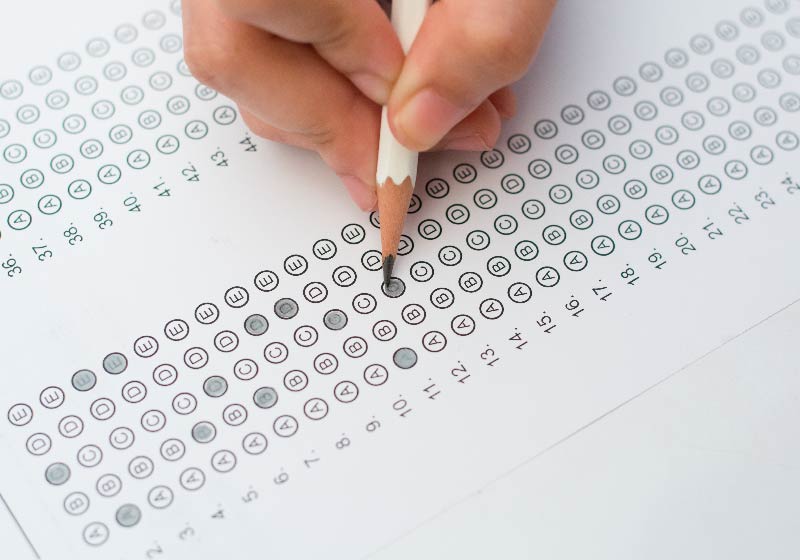By Jon McCreath, Technical Supervisor & Training Administrator
As an inspector, there are plenty of licenses and certifications that require strong test-taking skills in order to succeed. Perhaps the most difficult examination out there for inspectors is the National Home Inspector Examination (NHIE). Everyone tests differently, and some people have a tougher time when tasked with demonstrating their knowledge in scenarios where the stakes are high. Here are a few techniques to consider for setting yourself up for success in high-pressure exams:
Study the Material
Nothing beats good preparation, but what is good preparation? Slowly moving through covered material can be difficult and time consuming, which is why many resort to cramming. Cramming is the technique of covering a wide range of topics in a very small amount of time, typically right before a test or exam.
According to one study, 72% of students felt that cramming was more beneficial than evenly spacing their study time. Despite this belief, this same study found that methodical studying was more beneficial to 90% of the study’s participants.
Cramming can be a helpful review tool, but when reliably retrieving information in a high-pressure setting, slower, evenly-spaced studying leads to more consistent results. In short, put in the time to get results!
There are many tips surrounding studying that move beyond the scope of this article, but studying is the most crucial step for success. Consider teaching your test material to someone outside of your field to help demonstrate your knowledge, especially concepts that you might be struggling with. Take practice tests and find a study group. Do whatever works best for your learning style to digest the test material.
Reduce Day-Of Distractions
On the day of a proctored exam, there will be plenty of things on your mind. Work in advance to eliminate distractions, especially ones that are easily avoidable.
Consider visiting the testing facility in advance so that you know the best route. Give yourself plenty of sleep, arrange a good breakfast, and double-check that you have the required materials.
Arriving early and familiarizing yourself with your surroundings can go a long way to build confidence and calm nerves. Check to see where the clock is inside the testing room so that you can properly manage your time and pace yourself. Get in a comfortable physical condition and remove disturbances so that you can focus on what really matters: the actual exam.
Closely Read the Questions
Moving on to the actual test, there are many strategies you can employ to set yourself on a positive course. In all tests, effectively reading the question is of vital importance when looking for a correct answer, but there are a few common pitfalls people tend to encounter when reading questions. Test designers are checking to see if you are paying close attention, so note the details.
Single words like “none,” “not,” and “except,” can completely change the meaning of a question. These details have caused many to miss questions even though they knew the material. Don’t move too quickly to the next question. Slow down.
Ask yourself which skill or knowledge the question is testing you on. Sometimes the intention may not be clear on your first read, but use this consideration to point yourself in the right direction, particularly on questions you might be struggling with.
Try to construct an answer to the question before reading the given answers. This exercise increases your confidence, using the test to reinforce the work you did in preparation. If a given answer does not match your own, it might guide you towards the correct concepts.
Carefully Read the Answers
After using the question for your benefit, it is time to move on to the given answers. Knowing an answer with full confidence is great, but sometimes the answer might not come immediately. Do not panic. You can use the given answers to your benefit.
Compare the question to its answers. Some answers might not match well grammatically. Although there are exceptions to this rule, if the grammar does not fit, it is likely safe to throw out those options. Eliminating clearly incorrect answers is a good starting point to guide yourself to the answer, or build confidence in your selection. Make sure to read every answer before committing to one too quickly. One answer might be “correct,” while another answer is “more correct.”
Avoid answers that contain “absolute” words, such as: “always,” “never,” and “must.” Exceptions are common, and these words eliminate those possibilities. Additionally, key into words like “minimum,” “maximum,” “most,” and “least.” These words can change the context of answers. Again, slow down and read carefully to find these details that radically change the overall meaning of a statement.
After employing these strategies, you may still not be confident in an answer, and that is okay! Move on and return to tough questions later. Answering other questions can lead to an overall understanding of a test’s style. Potentially, later questions can contain hints to aid you in questions you pass over.
Lastly, answer every question! If these strategies have not led to a clear answer, an unanswered question is always wrong compared to a best guess. Use this information to instill confidence in your preparation and set yourself up for success.
Also, don’t forget to reach out for help! With a National Property Inspections franchise, you receive personalized training and coaching from our industry experts! Learn more about how to start your own property inspection business today!



